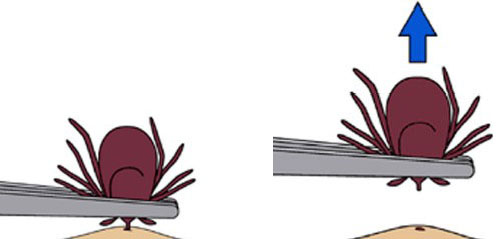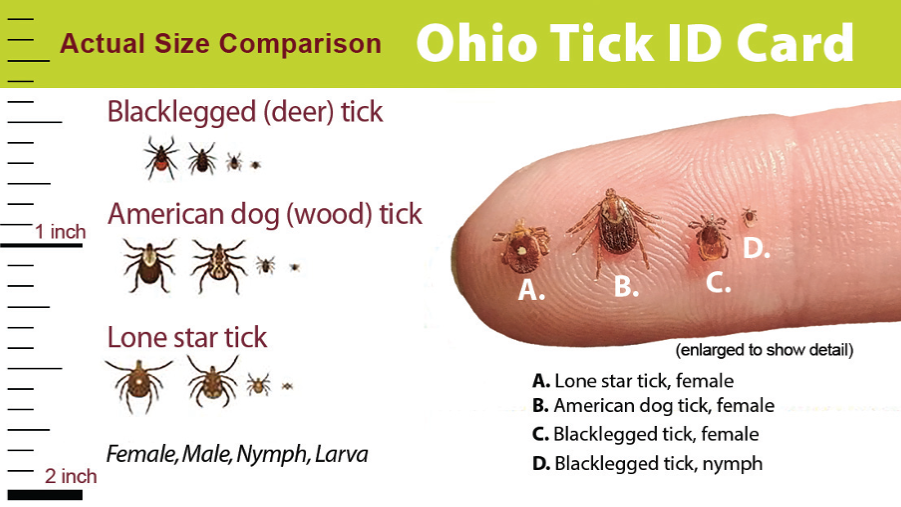
Canton City
Public Health
Amanda Archer, MPH
Health Commissioner
Environmental Health
Annmarie Butusov, RS
Director of Environmental Health
CONTACT US
330-489-3327
330-489-3335 fax
Hours: Monday - Friday
8:00 a.m. - 4:30 p.m.
(Excluding holidays)
Office Address
Canton City Public Health
420 Market Avenue, North
Canton, OH 44702
There are about a dozen species of ticks that have been identified in Ohio. Of these, three are responsible for nearly all tickborne diseases reported to the Ohio Department of Health: the American dog tick, the Blacklegged tick and the Lone star tick.
Diseases spread by Ticks, like Lyme disease (transmitted by an infected Blacklegged tick) and Rocky Mountain Spotted Fever (transmitted by the American dog tick), are increasing in Ohio. Be extra careful in spring, summer, and fall when ticks are most active.
Follow these simple guidelines to prevent tick bites:
PROTECT against tick bites
- Avoid areas where ticks live like wooded areas and places with high grass.
- Walk in the center of trails.
- Use tick repellents like permethrin to treat clothing and gear (boots, pants, socks, and tents).
- Cover up to keep ticks off your body.
- Wear long pants, long sleeves, and long socks.
- Tuck pant legs into socks or boots and tuck shirts into pants to keep ticks on the outside of your clothing.
- Light-colored clothing will help you spot ticks more easily.
CHECK for ticks
- Don't let ticks hitchhike!
- Remove ticks from your clothes immediately.
- Examine gear and pets. Ticks can ride into the home on clothing and pets, then attach to a person later, so carefully examine pets, coats, and day packs.
- Tumble dry clothes in a dryer on high heat for 10 minutes to kill ticks.
- Check your whole body for ticks.
- Bathe or shower ASAP after coming indoors
- Do a full-body tick check using a hand-held or full-length mirror to view all parts of your body upon return from tick-infested areas.
- Parents should check children under the arms, in/ around ears, inside the belly button, behind the knees, between the legs, around the waist, and especially in their hair.
REMOVE ticks as soon as you can:
- The best way to remove a tick is to use fine-tipped tweezers to grab the tick as close to the skin's surface as possible.
- Pull away from your skin with steady, even pressure.

- Don't twist or jerk the tick; this can cause the mouth-parts to break off and remain in the skin. If this happens, remove the mouth-parts with tweezers. If you are unable to remove the mouth-parts easily with clean tweezers, leave it alone and let the skin heal.
- If you are not interested in identification, dispose of a live tick by putting it in alcohol, placing it in a sealed bag/container, wrapping it tightly in tape, or flushing it down the toilet. Never crush a tick with your fingers.
- Wash your hands and the bite area with soap and water.
- Do not use petroleum jelly, a hot match, nail polish, or any other remedies to remove a tick. These methods do not work.

WATCH for symptoms
- The most common symptoms for tick-related illnesses are:
- fever/chills
- headache, joint pain, muscle aches, extreme tiredness
- rash
- Tell your healthcare provider immediately if you have been bitten by a tick and experience any of the symptoms described here.
For more information, contact Gus Dria, REHS at gdria@cantonhealth.org or 330-438-4647
Tick Resources:
- Ticks in Ohio - Ohio Department of Health
- Be Tick Smart! - Brochure
- Ticks - CDC
- Preventing Ticks on Your Pets
- Reducing Tick Habitat Around Your Yard (video)
- How to remove a tick (video)
Healthy neighborhoods, healthy neighbors, healthy families.
Last updated 2022.05.31




